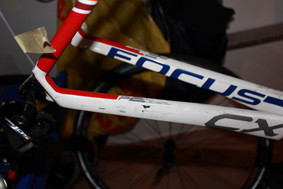
At regular intervals we have repair requests due to transport damage, classic roof transport. This usually affects the handlebars, stem and head tube or the transition to the down tube. If the collision has been relatively mild, we recommend replacing the handlebars and stem. Regardless of any visible cracks, the frame itself should undergo a non-destructive inspection for further safety to rule out any hidden structural damage (delaminations).
Fahrradtransport eines Carbonbikes mit dem Auto auf Deutsch lesen
How do I transport my carbon bike ?
One of the fundamental considerations for an avid cyclist who loves their sports equipment is how to transport it by car. Whether on the roof, at the rear (hatch), on a trailer hitch, or inside the car itself, certain factors should be taken into account, and risks should be assessed beforehand.
The safest option is to transport the complete bike inside the car, be it a station wagon or a van. This way, the expensive bike is best protected against gravel impacts, vibrations, adverse weather conditions, and the risk of overlooking insufficient clearance heights. Not to mention the theft risk, which is also minimized with this method.
However, not everyone buys a car specifically suited for transporting bicycles. If you're considering purchasing a new vehicle, you may take this into account.
If buying a new car is not on the table, there are three other options available:
- Trailer hitch
- Rear attachment
- Roof rack transportation
Road bike transport trailer hitch
If a trailer hitch is available, this option is the top choice. The mountain bike (MTB) or road bike is largely protected and positioned within the car's wind cover, but it may also create aerodynamically unfavorable turbulence. Loading and unloading the sports equipment is comfortable, and an additional advantage that most trailer systems offer is the ability to fold them away, keeping the trunk freely accessible.

There are fixation systems with straps and eyelets, as well as with screw/clamp connections, but be careful! Carbon is highly sensitive to pressure, and a tube can easily crack or crush due to uncontrolled tightening, leading to a serious structural damage. This damage might go unnoticed initially but could progressively worsen under further stress during the use of the bike, eventually resulting in sudden failure. Caution, danger to life and limb!

Here is an example of structural damage caused by excessive clamping and vibrations while driving. It shows a typical crack pattern in the paint, indicating damaged carbon structures.
The disadvantage of the trailer hitch is the limited visibility while maneuvering and the associated risk of crashes. The roof rack provides better visibility, but again, there is a risk of collisions with low clearances.
Bicycle transport using the rear hatch
If no trailer hitch is available, the rear hatch carrier remains an option. The fixation is done using tension straps held in place by stoppers and guided through the gap between the rear body and the rear hatch. However, the straps can come loose during the ride due to wind and vibrations, causing the carrier to shift and, in the worst case scenario, scratch the car.
The disadvantage of using the rear hatch for transportation is the limited visibility while maneuvering and the associated risk of crashes, although it is somewhat less compared to the trailer hitch since it is more compactly attached to the vehicle.
Bicycle transportation using a roof rack
If there's no space inside the car, no trailer hitch available, and the personal risk of using a rear hatch carrier is too high, the roof rack remains an option. Roof rack systems for bicycles are available at affordable prices, but it's essential not to compromise on quality. However, it's important to consider the slightly more cumbersome loading process and increased fuel consumption. Not to mention the risk of collisions with low clearances, as well as the additional stress on the carbon bike due to vibrations and lack of protection against flying debris.
At this point, it should be noted that using a tarp to protect the expensive bike is not a good idea, as it significantly increases fuel consumption and compromises driving safety.
Conclusion: Transporting a Carbon Bike
The ideal way to transport a carbon bike is inside the car's interior. It provides protection against wind and weather, shields against vibrations that could affect the carbon structure, and keeps the vehicle's driving performance unaffected while offering maximum theft protection. When securing the bike, be cautious not to crush the carbon structure by overtightening clamps. Additionally, ensure the bike is securely prevented from sliding inside the car.
When transporting the carbon bike inside the car, be mindful of not leaving it in a closed car during extremely hot summer days. Upon arrival at your destination and under intense sunlight, take the carbon bike out of the car to avoid potential damage caused by extreme heat.
If there is not enough space inside the car, we recommend using a trailer hitch as the next option, followed by the roof rack. For those traveling abroad with their bikes, please inquire about the national regulations, such as additional marking for protruding cargo beyond the vehicle's outline. Always adhere to the recommended maximum speed of 120 to 130 km/h for external bike rack systems, regardless of their type.
In this spirit, "keep cycling" and ensure a safe transport for your precious road bikes - the Carbon Bike Service!
Share with friends
Start your request on our CONTACT page.


Kommentar schreiben